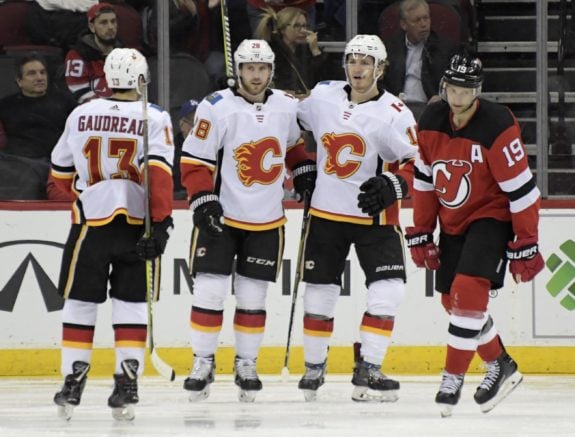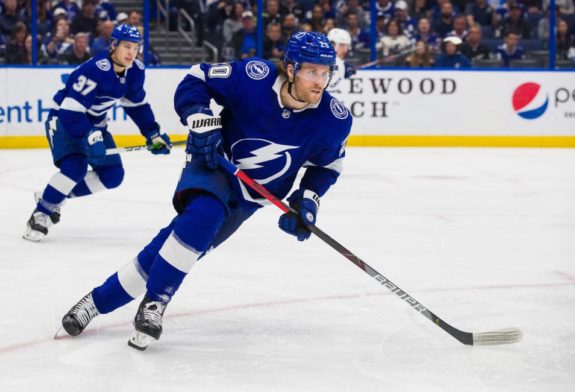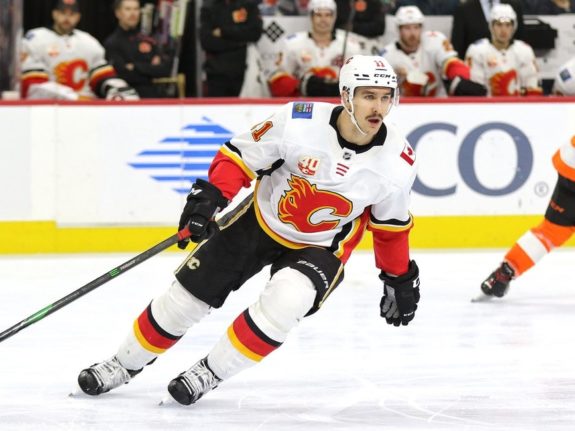Before we dive headfirst into projecting the Calgary Flames’ forward group combinations, I just want everyone to know I’m well aware the club is a very interested party in the Jack Eichel trade sweepstakes. If general manager Brad Treliving manages to secure the elite first-line center, then all bets are off and these potential units will become null and void. So, for the sake of this exercise, let’s assume Calgary won’t be making any more major deals involving forwards this offseason.
The First Line: If it Ain’t Broke, Don’t Fix it
OK, this one is a no-brainer. In the waning months of the 2020-21 season, the Flames’ coaching staff finally broke up the “Johnny and Mony” express and launched a brand new top line that featured Johnny Gaudreau, Elias Lindholm, and Matthew Tkachuk. That trio came together in early April, stuck around for most of the team’s final 16 games of the season, and the results speak for themselves. Tkachuk finally found some serious chemistry and potted six goals and 12 points in his final eight contests, while Gaudreau had an eye-popping 22 points in his final 16 games.

Meanwhile, Lindholm simply kept on doing what he’s been doing since he joined the Flames at the start of the 2018-19 season: be the team’s most versatile and consistent forward. There’s no reason head coach Darryl Sutter won’t roll out these three as the top unit right out of training camp. Whether or not they stay together all year remains to be seen, but if that solid 16-game audition was any indication of future success, I’d say this line is here to stay for the foreseeable future.
The Second Line: Adding Coleman Gives the Flames Multiple Options
It doesn’t really matter if you consider recent signing Blake Coleman to be a top-six or a middle-six guy – the Flames are very likely going to utilize the two-time Stanley Cup winner on the team’s second unit. Coleman will bring great speed, a responsible two-way game and some true grit to Calgary’s forward group, but who will he play with? The first option could see Sean Monahan center the line with Andrew Mangiapane on the left side. This combination will only succeed if Monahan can rebound from a couple of down seasons that saw his offensive production fall off dramatically.

Another intriguing option would be to load up all of the Flames’ best two-way forwards and slot Mikael Backlund at center with Mangiapane and Coleman. By combining the trio’s shutdown ability with the play-driving skill of both wingers, this could make for a really dangerous line that would stack up well against any of the opposition’s top units. A third, and a less likely scenario would see Dillon Dube slide into the left side with Monahan at center and Coleman at right wing. This move would obviously bump Mangiapane down to a third-line role and create a slightly different-looking shutdown unit.
The Third Line: Backlund Will Continue to Anchor Shutdown Line
It’s a pretty safe bet that Calgary’s third line will feature some combination that features the rock-steady Swede at the center position. Backlund will continue to be one of the Flames’ best two-way players, but who will we see skating as his wingers when they drop the puck on the 2021-22 season? Milan Lucic saw some good results playing next to Backlund, but so did Mangiapane and Dube. I think the takeaway here is that the 32-year-old centerman has a long history of making his linemates better, so we may see a few different players rotate through the third unit.

Newcomer Tyler Pitlick is seen primarily as a defensive winger who can play on the penalty kill, so we could definitely see him slotted with Backlund on a shutdown line. Dube would be the obvious choice to play the left side on this line, with the hope he can generate offence while still playing a responsible defensive game. Keeping Mangiapane on the third line would make it even harder to score on, but I’m sure the Flames coaching staff is hoping the speedy winger will take his offensive game to the next level – and that means giving him a top-six role.
The Fourth Line: The Possibilities Are Endless
The departure of the always-dependable Derek Ryan means the fourth line center position is suddenly wide open. With the fresh signing of Trevor Lewis to a one-year deal, the Flames have the flexibility to play the veteran forward at either center or on the wing. Darryl Sutter utilized the 6-foot-1 Lewis primarily as a center for both of the Los Angeles Kings Stanley Cup runs in 2012 and 2014, but recent years have seen the former Winnipeg Jet play on the right side.

Also in the mix for the fourth line center job is AHL prospect Glen Gawdin, who played a handful of games with the Flames last season and could be ready to secure a full-time NHL gig in September. If Gawdin gets the nod up the middle, then we could see Lewis at right wing, or even recent depth-signing Brett Ritchie, who had a surprisingly solid season after joining the team on a PTO. If Lucic isn’t reunited with Backlund on the third unit, he would be the best option to slot in at left wing. After posting his best offensive numbers since 2017-18, the Flames must decide exactly where in the bottom six they want to utilize the big galoot.
Prospects Making a Push Could Further Muddy the Waters
We haven’t even talked about a couple of other AHL players who could throw a serious monkey wrench into these line configurations. Both Adam Ruzicka and Matthew Phillips were called up at the end of the 2020-21 campaign and could theoretically challenge for a roster spots out of training camp. The undersized Phillips is offensively gifted and would not be well suited for a “grind line” role, while Ruzicka is a big centerman who could be slotted on the wing somewhere in the middle six to start his Flames tenure. If either of those players makes the opening night roster, we will definitely see some further line juggling. We’re still seven weeks from the opening of training camp, so a lot can still happen, but I feel it’s never too early to imagine what the Flames’ forward ranks will look like to start the season.
